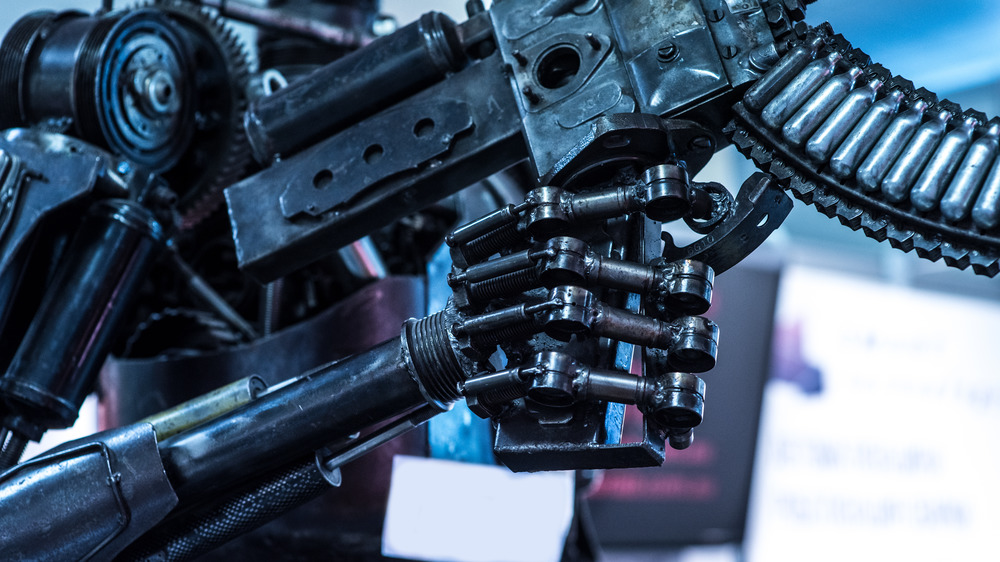Prototype Weapons That Offer A Glimpse At What The Future Of War Looks Like
Step back, Call of Duty: Advanced Warfare – it's time to look at future murder on the real. Are we talking camo suits like Gray Fox's from Metal Gear? Mech armor? Laser swords? (How about Samuel L. Jackson's purple lightsaber in the "Star Wars" prequels?) Orbital space cannons? Electromagnetic rail guns like that giant one that the U.S. Navy has (check it out on YouTube – yikes)?
The short answer is: yes. The future is here, the future is now, and the future is guns. Lots of guns. Somewhere in between all the Winchesters, mortars, napalm, and planet-destroying nukes, it seems like there are still plenty of creative ways that millions of "intelligent" primates can annihilate each other while padding the coffers of arms developers and tyrants.
Take the Department of Defense's (DoD) promo clip on CNN about its goal to achieve "artillery supremacy over its adversaries" by firing guided, "Excalibur" projectiles to obliterate derelict trucks at a range of 43 miles from the Army's Extended Range Cannon Artillery (ERCA) in Arizona's Yuma Proving Ground. Explosions! Just don't overshoot, or you'll accidentally detonate a farmhouse in Kansas.
But really, the future of warfare is as predictably inevitable as it is frightening. As Pocket Lint shows us, it's every militaristic dystopian dictator's wish-list: killer robots, handheld and mounted laser guns, user-authorized handguns, hypersonic missiles, cybernetic body suits, stealth tanks, and more. Somebody call the Master Chief: The Terminator's about to run wild.
Go stealth or go non-lethal
So let's look at the stealth stuff first. ADAPTIV, as the BAE Systems website describes, is a Swedish-designed stealth technology that covers tanks, helicopters, ships, what-have-you, in hexagonal, honeycombed cells that render them invisible, blend them into their surroundings chameleon-style, or even make them look like another vehicle altogether (at least to thermal sensors). On the personal level, Hyperstealth Biotechnology has developed what looks like an honest-to-goodness cloak of invisibility from "Harry Potter." The fabric-like material, trademarked "Quantum Stealth," as De Zeen depicts, is a "lenticular sheet" similar to those shimmering-faced trading cards. It can, as boasted, not only make a person vanish, but also an entire building.
There are also a lot of non-lethal (but still dangerous) devices. TASER Shockwave is a kind of super stun gun designed for riot control and subduing mobs. As News Atlas says, its six-gun design is composed of modular blocks that can be "stacked together vertically to allow for multiple salvos over a reduced area, or horizontally to cover a larger area." Apparently, the guns can be networked with other guns to make huge, daisy-chained nets of electrocution.
Similarly, we've got Long-Range Acoustic Devices (LRADs) which are "sound cannons" that generate high frequencies that cause pain, disorientation and nausea. These have, in fact, per Pitchfork, already been questionably deployed against people such as Black Lives Matter protesters. Finally, the Active Denial System (ADS) is basically a heat gun that fries your skin with microwaves, per the DoD's Non-Lethal Weapons Program.
Battle droids, anti-drone tech, and cybersuits
The QinetiQ company's website says that they "deliver multi-domain solutions that enable our customers to overcome the next generation of threats." Aside from the disturbing use of the word "customer" (they're integrated into the U.S. Defense Counter-intelligence and Security Agency), what does this mean? It means killer robots that definitely look like they'd be the first things to go rogue in an R-rated "Black Mirror" episode. QinetiQ's MAARS (Modular Advanced Armed Robotic System) robots are unmanned, tank-treaded death boxes intended for use in "ambushes, hostage rescue, forced entry, booby-trapped areas, detainee riots, site security and IED." They shoot lasers, non-lethal grenades, quite-lethal grenades, and bullets. Lots of bullets.
On the defensive side of things, we've got countermeasures like Droneshield's DroneGun MKIII, which, as the product page shows, looks like it shoots kitchen floor tiles. But no, you point it at a drone and pull the trigger to not only disable the drone, but command it where to land. All the while, the gun's "RF disruption activation" interrupts transmissions and visual feed headed to the drone's operator.
And to help soldiers carry anti-drone guns and other cumbersome equipment, companies such as Lockheed Martin, per Army Technology, have developed a "robotic load carriage exoskeleton" called a human universal load carrier (HULC). It's hydraulically powered and transfers weight to the feet, which allows the wearer to carry up to 200 pounds without any trouble while preventing "musculoskeletal injuries." Not quite Ripley in "Aliens," but we're getting there.
Guns, lots of guns
When in doubt, shoot. That definitely seems to be the guiding principle behind much of the future of combat. But now, we can shoot not only bullets, but smart bullets, more bullets, lasers, bigger lasers, and more. The Smart System on the Armatix website allows a handgun to be fired only when its radio-controlled watch is nearby (sorry, no palmprint like in "Judge Dredd"). These might be not be a match for the ADS 5.45mm amphibious assault rifle, however, which, according to Defense World, can shoot not only on land, but up to 20 meters underwater at a reliable range of 18 meters.
As for lasers, the Laser Weapon System (LaWS) is a mounted cannon-looking thing controlled remotely with what looks like an off-brand Xbox controller, as this YouTube clip shows. It shoots lasers at the speed of — you guessed it — light. Unfortunately, there's no colored laser beam. Additionally, Boeing's "Laser Avenger," per its website, is designed to shoot down unmanned aerial vehicles (UAV), while its High Energy Laser Mobile Demonstrator (HEL MD), per Laser Focus World, is basically a juiced version of the same thing.
Finally, there are firearms. The FosTech Origin 12 stands out as the world's "fastest semi-automatic shotgun," per a demo on YouTube. Then there's Cornershot, which as their website shows, is a gun with a hinge and a little screen to let you shoot around corners. Just don't forget to turn it forward again after you've turned.



